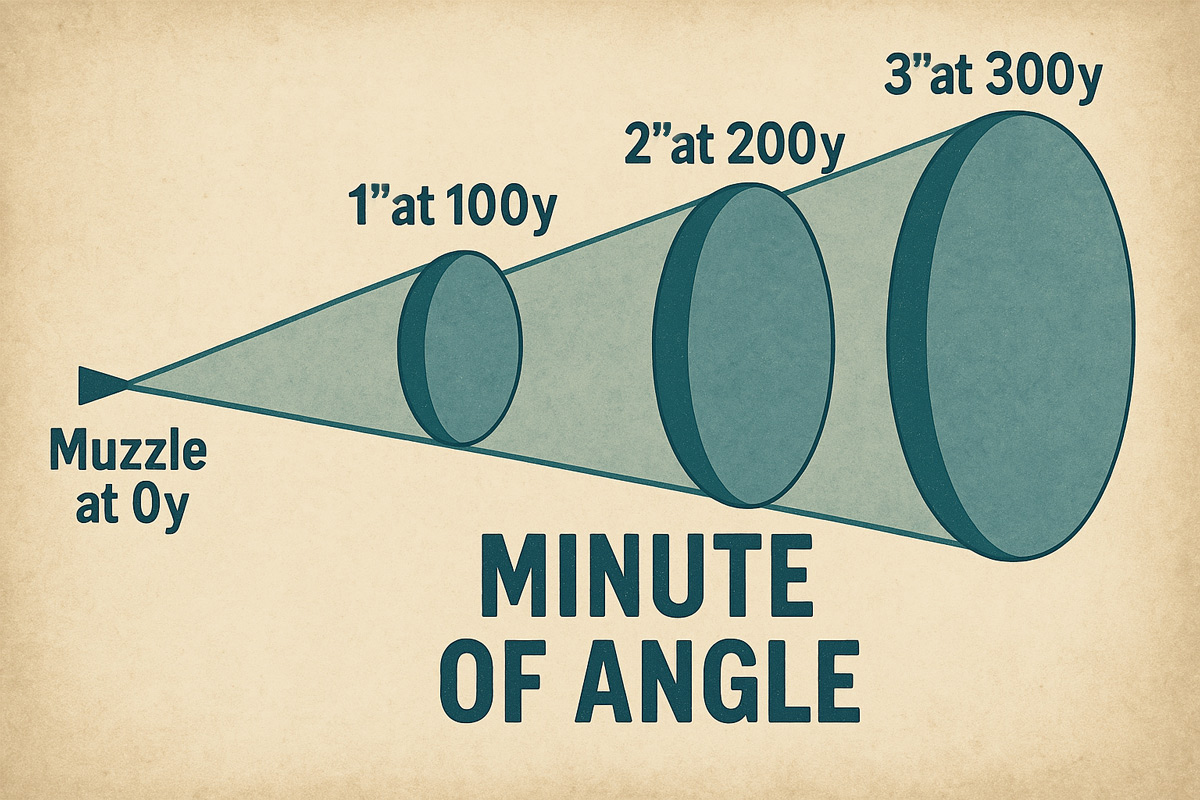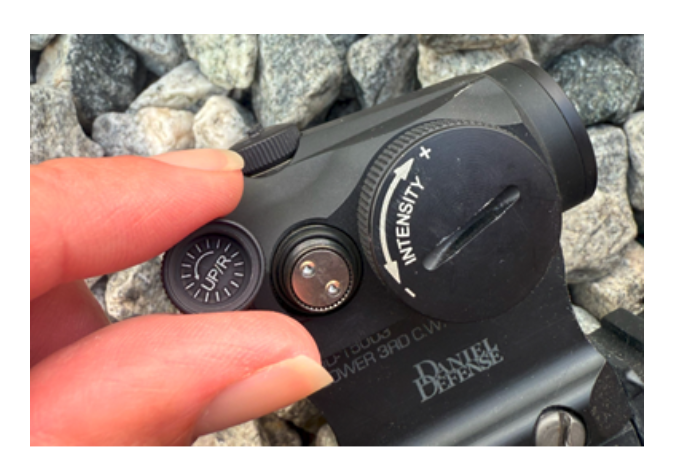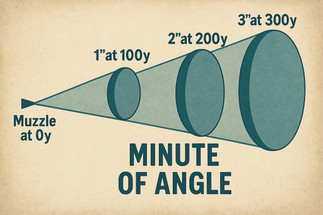Apr 23rd 2025
Minute of Angle (MOA), What are you talking about?
This week’s blog article is brought to you by industry friend, Brook Bowen.
Always Better® | April 24th, 2025
We have all heard “I have a sub-MOA gun” or “it's a 5 MOA red dot optic” or “come up 2 MOA from your last shot.” What does all of that mean? There are plenty of articles out there describing the math of Minute of Angle (MOA) and lots that compare them to Milliradians (MILs). You don’t even have to go past the Google AI description to get the math. Here, I will explain how we commonly use MOA and what the hell our friends are talking about with the above statements.
Most people already know that a Minute of Angle (MOA) is an inch. That is only “true” at 100 yards. Remember that MOA (and MIL) are angular measurements. A minute of an angle is 1/60th of a degree, they can be broken down again into seconds for use in navigation (think latitude and longitude). We are looking at angular measurement in the aspect of shooting, so we are looking at the length of the angle or size of a circle from that angle at distance. Since an angle is uniformly expanding from the point of origin, we can measure it at known distances. If we were to use just degrees we would be talking about 62.82 inches at 100 yards, likely larger than our target. So, we break it down into minutes of degrees, 60 minutes so we have a smaller unit of measurement. Using math and being precise, a minute of an angle equates to 1.047” at 100 yards. Almost everyone rounds that down to 1” at 100 yards. They can because at 1000 yards that extra decimal is only .47”. Most of us don’t have rifles or the physical capability that can adjust a half an inch at 1000 yards nor can most of us measure that from 1000 yards away.

With the common understanding that an MOA is equal to 1” at 100 yards we can also understand that that angle increases uniformly 1” per 100 yards. Meaning that an MOA is 2” at 200 yards, 3” at 300 yards and so on. So, when a shooter says he has a “sub-MOA gun,” he means that his rifle shoots groups smaller than an inch at 100 yards, but he can be talking about 5” groups at 500 yards. **Sidenote: Most Mil Spec rifles were contracted to be sub 4 MOA. Most shoot closer to 2 MOA, but 4 is the requirement.** There are plenty of AR style rifles that shoot sub-MOA groups without much modification. Also important to note is that just because a rifle shoots 1 MOA at 100 or even 300 yards, doesn’t mean it will still shoot 1 MOA at longer ranges. The angle of measure for an MOA is constant, the effects on the bullet during its flight can increase that cone of fire. Those effects are the shooter, ballistic coefficient (Google it), muzzle velocity (MV), gravity (remember your bullet is dropping as soon as it leaves the muzzle), wind, altitude, and other environmental factors.
BLUF: If you want your rifle to maintain 1 MOA at longer distances you will need to find a projectile and MV that will minimize those effects.
With this knowledge, we can now talk about the size of reticles. If you have a red dot that is 3 MOA, that means that at 100 yards that dot will cover 3” of the target. That’s why when we talk about pistol dot sizes, it can be said that large dots (5 or 6 MOA) are good for fast target acquisition at close ranges and smaller dots (2 or 3 MOA) for longer ranges and more precise aiming. In reality it’s just a matter of perception and opinion, because at 25 yards a 6 MOA dot only covers 1.5” of the target. This can also refer to the size of a circle or a horseshoe found in reticles from Eotech, Trijicon, Vortex, etc.
Now when you have a reticle divided into MOA (or MILs) like a crosshair or “tree style” you can measure at distance. It will depend on how much your reticle is divided into fractions of MOAs and how many reference lines you have in your reticle to what degree of accuracy you can measure. Also, of note is at what magnification your reticle is true for a second focal plane scope (usually minimum or maximum) or if your scope is first focal plane it will be true at any magnification. If you have a “tree” style reticle like the Horus H59 you can now use it to measure and make adjustments for both zeroing (without walking to target and using a ruler) and for follow up shots. If the reticle has lots of reference lines, both horizontal and vertical and you are able to stay on target to watch your impact, you can actually shift that point of impact to your desired point of aim and make a second round hit. A key point when using a scope with a reticle using MOAs is to make sure the adjustments in the turrets are also MOA. Back in my early career we had MIL reticles with MOA adjustments, and it was like thinking in two languages. Most MOA scope turrets are broken down into ¼ MOA increments. If you have a “ tree” style reticle in either your rifle or spotting scope you will be able to spot impacts and give accurate (because you measured the distance from point of aim with your MOA reticle) corrections for a shooter you are spotting for.

Hope this cleared up some of the ways MOA is used in modern shooting and what people mean when they talk about “ sub-MOA” guns, the size of a reticle, making adjustments to your zero or point of aim. If you want to nerd out or get in the weeds about the math, you can Google “what is an MOA” and you will get the exact mathematical breakdown and visual diagrams. I would also recommend researching MOA vs MIL and seeing the differences on those two angular measurements because as long range shooting sports and hunting become more popular you’re going to start hearing a lot of people talking about MIL based reticles and scopes. I’ll give you a head start, a MIL is 3.6” at 100 yards, but your turrets are broken down into 1/10 of Milliradians (about .36 of an inch).
About Brook Bowen
Brook Bowen has over 28 years of combined federal service experience, including his time with the 2nd Ranger Battalion and as a federal agent. For over a decade, he served in multiple roles as a member of the Border Patrol’s BORTAC team. Throughout his career, and into his retirement, Brook has specialized in training. He has provided training to military personnel, law enforcement, and responsible civilians in the U.S., as well as to foreign law enforcement units in multiple countries. Today, he continues to consult and deliver training as a contractor and as the owner of Two Bravo Solutions LLC. You can find other articles and gear reviews from Brook at Spotterup.com and Mind4Survival.com
About Blue Force Gear®
BFG, headquartered in Pooler, Georgia, has been a trusted name in professional-grade gear and accessories for two decades. Their commitment to excellence, innovative designs, and use of premium materials have made them a favorite among military, law enforcement, and recreational shooters worldwide.
Press Contact
PR Contact: Marketing@blueforcegear.com
Sales and Dealer Contact: Sales@blueforcegear.com

